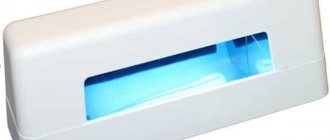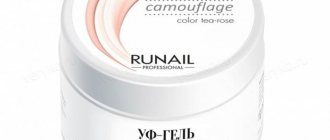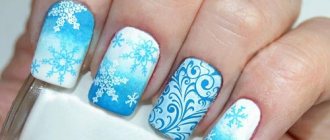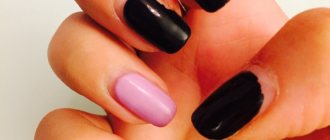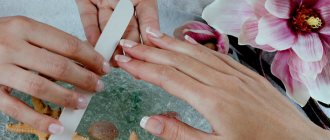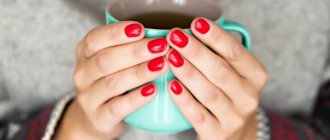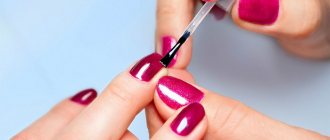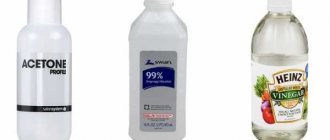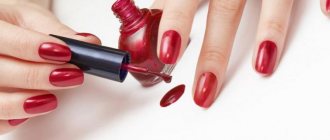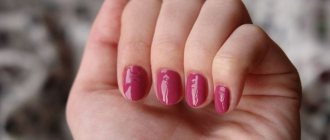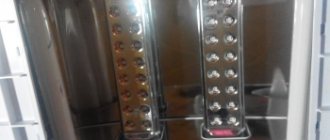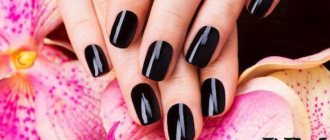Without a manicure, as well as without the right accessories, it is difficult to create a truly worthy and complete look. Modern technologies for applying a coating to nails make it possible to extend the beauty of a manicure (for up to 4 weeks). This is not fantasy. Gel polish is an innovative solution that allows you to avoid the need for extensions. The technology for applying gel polish is quite simple, but requires compliance with certain rules.
Preparation
Naturally, first you need to get a manicure. This is the first rule. What type of manicure should I choose? It's up to you to decide. This can be a hardware manicure, edged or European. The technology of applying gel polish implies the absence of any cream on the hands, not only at the time of applying the material, but also on that day in general. After the manicure is done, you can proceed to the next stage. This is degreasing the nail plate. This can be done either with a special product or with simple alcohol. It is very important not to touch your nails after this.
Procedure
You need to file your nails during the manicure. If you neglected this, then you need to remove the length and shape it before degreasing the plates. The dust that is generated must be removed very carefully. If this is not done, then there is a risk that the material will peel off, lie unevenly, chip and peel. When all the manipulations have been completed, you can begin the procedure itself. The technology for applying gel polish requires you to follow all these steps:
- first apply the base for gel polish;
- dry it in a UV lamp or LED lamp for as long as indicated in the instructions on the bottle;
- then apply a thin layer of colored gel polish (the brush is carefully squeezed onto the edges of the bottle);
- dry the layer in a lamp for as long as the instructions require;
- if necessary, apply a second layer of colored gel polish;
- dry as much as the first layer;
- then apply a finish or fixative (indicated on the bottle: TOP COAT);
- dry it according to the instructions on the bottle.
It is noteworthy that the material from different companies has different consistency: from very thick to completely liquid. It is important to ensure that the gel polish does not flow onto the cuticle or side ridges. If this happens, then you need to remove the excess with a cotton swab dipped in nail polish remover, and carefully so as not to smear the entire gel polish. The application technology also implies a certain order:
- first, four fingers on one hand (except the thumb; if right-handed, then on the right);
- then four fingers of the other hand;
- then on the thumbs of both hands.
This is due to convenience. This makes it easier to dry your nails in a lamp. Even the simplest and low-power (9 Watt, for example).
Abundance of options
Modern companies producing materials for nail artists offer a huge number of options. One of the best, but budget-friendly, is Lidan gel polish. The application technology is no different from that described. Drying time in the lamp is 60 seconds. This is for a power of 36 watts. The LED lamp allows you to dry each layer in 30 seconds. Depending on what type of equipment you are using, the time may vary. The technology for applying gel polish is simple and does not require any special skills. Any beginner can handle this, even if not always the first time.
Clients of beauty salons often complain to nail designers that the manicure does not last long. This happens if you do not allow the coating to dry completely. To avoid such problems, a specialist must know: the process can be slowed down or accelerated by using different types of lamps.
Do I need to dry the base in a lamp?
To dry the base, use ultraviolet or LED lamps. It is recommended to read in advance the instructions that come with the bottle with the base about how much time it takes for complete drying. If this time is shortened, problems will arise with applying the top layer. If you expose your nails to a light source, the texture of the base will become deformed, and this will also negatively affect the quality of the manicure.
After waiting the required time, the master applies a colored coating to the nails. After this, the nails dry again. The rule here is very simple: the color coating dries exactly as long as the base.
Harm from ultraviolet radiation
However, do not forget that short-wave UV radiation is harmful not only to viruses, but also to humans. Such ultraviolet radiation can damage your eyes, permanently ruining your vision, or disrupt your DNA if there are open wounds on your body and they are exposed to such light.
In fact, uncontrolled exposure to such waves can cause cancer.
First of all, the disinfection effect is influenced by the dose received. Here we can give analogies with radiation.
The greater the intensity of the radiation source, the greater the dose bacteria and microbes will receive in a shorter period of time.
Please note that UV bulbs indicate the total power, which includes both short ultraviolet and other emission spectra (warmth and just beautiful blue light).
For example, for a 10W UV germicidal lamp, the power of the killing rays can be only 2.7W. It is this parameter that you should pay attention to when choosing.
How to properly dry gel polish in a lamp
To ensure that the gel polish dries well, you must keep the following in mind:
- Some types of gel polish contain substances that change their structure under the influence of ultraviolet rays. Therefore, before placing your nails under the lamp, you need to carefully read the instructions.
- Before work, you need to carefully inspect the lighting fixture. If there is any external or internal damage, do not use the device.
- After each client, the lamp must be disinfected without fail.
- Once a light bulb has expired, it needs to be replaced, even if it still shines brightly. If you use a lamp that has expired, the coating will not be durable.
Nail dryer: how to choose, prices and reviews
- When purchasing and using a manicure machine for the first time, inspect the equipment for external damage (case cracks, cord defects, scratches, etc.).
- Connect the device to a power source.
- If there is a timer, select the drying time. If there is a touch sensor, then insert the fingers of one hand (except the thumb) into the hole in the housing and the lamp will turn on itself.
- It is advisable to place nail plates coated with varnish as horizontally as possible under the emitters. If the device has a spherical shape, then the radiation will be distributed evenly.
- Once drying is complete, insert your thumb with the nail plate facing up.
- Repeat the procedure on the other hand.
- After finishing work, turn off the device. Clean any possible contamination.
- Store the device in a case or box so that dust does not get inside the case or on the paws.
How long to dry the base?
The rules for drying the base depend on what kind of lamp is used. Therefore, different masters take different amounts of time to work.
How long to dry gel polish in an LED lamp
Drying time using an LED lamp depends on its power:
- 6 watts – the base dries in half a minute, the main layer will have to spend twice as long;
- 18– the base can be finished in 20 seconds, gel polish and top will dry 10 seconds longer;
- 20–same time;
- 48–5 seconds are spent on the base, 15 on the polish.
Such light bulbs are expensive, but they have a long service life.
How long to dry gel polish in a UV lamp
When using ultraviolet light source, the time will be as follows:
- 9 watts – 2 minutes for base, 5 minutes for gel polish and top;
- 18– 1 minute for base, 3 minutes for varnish;
- 36 – 1 minute and 2 minutes respectively;
- 48 – the same indicators.
Ultraviolet light bulbs are inexpensive, but they burn out frequently.
How long to dry the base in a 36 watt lamp
Not all masters know how long to keep their nails under a 36-watt lamp, since ice devices with such power are rarely used: 48-watt bulbs are more common on sale. If the master has a 36 W LED device, the time will be as follows: 10 seconds will be spent on the base, 15–20 seconds on the varnish.
How long to dry the gel in a 9 W lamp
Ice devices with 9 watts are the smallest in power. However, the drying speed of the coating will still be faster compared to a UV lamp of similar power. It will be: 30 seconds – base, 1 minute – main coating.
Size
- Timer. This basic and very convenient function allows you to set the drying time of gel polish (shellac, gel). With a timer, you don't need to be distracted from the manicure process and time the drying time; the lamp will do it for you. Different lamps have different numbers of time buttons, they can be: 10, 30, 60, 90, 120 sec.
- Touch trigger mechanism. This function allows you not to be distracted by constantly turning the device on and off. In order for the lamp to work, you just need to put your hand in the lamp. If you remove your hand from the lamp, it will turn off.
- Countdown display. A convenient function that displays the remaining time of the timer.
- Built-in fan. It blows the nails during drying, which significantly reduces the risk of burning during polymerization of the material. In addition, the fan performs the cooling function of the heating elements, which will help increase their service life.
- Removable bottom. Improves the quality of cleaning the lamp from materials that have fallen on it. And also, this is a very convenient function when performing a pedicure.
Is it necessary to dry the top in a lamp?
Recently, special types of topcoat have appeared on sale: when it is applied to the nails, it speeds up the drying process of the color coating. It does not require special drying (and this will be mentioned in the instructions).
Other types of topcoat can be dried in the same way as varnish and base, using lighting fixtures of varying power. Since the topcoat is usually applied in a thinner layer compared to a color coating, low-power light bulbs can be used to dry it. The best option is an 18-watt ultraviolet lamp or a 9-watt LED device. In this case, the final layer of manicure will dry quickly and efficiently, and your nails will maintain a neat appearance for a long time. If the top coat contains glitter, it may take a little longer to dry. This time must be maintained, otherwise the structure of the sparkles will be deformed and they will lose their beauty.
Strip under the nail
Subungual melanoma is a form of acral lentiginous melanoma, which in turn is a type of cutaneous melanoma, an aggressive cancer with a high mortality rate.
“The proportion of acral lentiginous melanoma varies in different regions of the world and averages 5% of all types of melanoma. Tumors are more often localized in the area of the feet, of which a quarter are subungual melanomas,” notes Grigory Zinoviev, Candidate of Medical Sciences, oncologist, surgeon, head of the surgical department of tumors of bones, soft tissues and skin, National Medical Research Center of Oncology. N. N. Petrova.
7004 Evil under the sun: how to save yourself from the most common type of cancer
Subungual melanoma has two stages of development: horizontal and vertical. At first, the tumor looks like a brown or black stripe under the nail. Then the free edge of the nail, the nail fold and the skin are gradually pigmented. In a third of cases, amelanotic melanoma occurs, which is difficult to notice.
The first symptoms develop at the vertical stage, when the tumor grows into neighboring tissues: the nail becomes deformed, the nail plate becomes dull, becomes thinner and breaks. When the nail cracks, you can see a lumpy, bleeding surface that is brown or black underneath.
As the tumor progresses, it can spread to the fingers, feet, or hands. The patient experiences weakness, loses weight, and develops a fever. The rate at which the disease develops varies—metastases may appear within a year or several years.
How long to dry the top
In domestic beauty salons, ultraviolet lamps with a power of 18–20 watts are usually used to process the final coating of nails. LED devices are used less frequently due to their high cost. A 20W UV light will dry a thin layer of topcoat in 3 minutes. Processing the top applied in several layers will take 4 minutes. Working with glitter may take 4.5 – 5 minutes. In this case, the master must warn the client that the final stage will take longer.
How does UV kill viruses?
How does it all work? The fact is that the virus does not have a protective cell wall or membrane.
Therefore, short UV waves calmly penetrate into its interior and act directly on DNA and RNA, destroying them. But it is the doubling of the nucleic acid molecule that is responsible for the reproduction of the microorganism.
Even if UV rays do not kill the infection (low intensity or duration of irradiation), they still stop its reproduction. And if you cannot reproduce, then you no longer pose such a danger to other healthy cells.
But what is most important is that none of the viruses can adapt to such irradiation.
What does it mean? There are several types of disinfection of premises, including chemical.
So, during chemical treatment, there is some probability that certain types of viruses and microorganisms may subsequently change and develop resistance to certain solutions or their concentrations.
But there is no protection from UV. No matter how the infection changes, the direct impact of hard ultraviolet radiation on its nucleic acids will ultimately cause it to die.
They are afraid of such radiation, like vampires of the sun.
No matter how new and unstudied the virus is (Covid-19, SARS, etc.), it still has DNA, RNA, which means short-wave UV will penetrate its insides and destroy it from there.
According to studies, for irradiation efficiency to be 99%, a dose of about 1000 μWsec/cm2 is required.
This intensity will kill all viruses containing RNA, single-stranded DNA (coronavirus), and with a greater probability of 90% RNA, double-stranded DNA.
Features of the procedure
As noted above, the peculiarity of the procedure lies in the special conditions for drying the coating in a lamp. For this purpose, UV lamps, LED or combined type lamps are used.
Theoretically, it is possible to dry regular gel polish (if it is not a special non-photosensitive product) without a lamp, because the sun's rays also contain ultraviolet radiation.
This process will only take a lot of time, and the quality of the manicure will leave much to be desired - uneven drying in the fresh air will lead to peeling, swelling of the coating and staining of your natural nail. Therefore, it is better to use a special lamp - fortunately, there is plenty to choose from.
The lamp power determines the drying time of the coating. Basically, manufacturers produce UV lamps with a power from 9 to 54 W, LED devices with a range of 12-45 W and a hybrid with 36 W of power.
A UV lamp is perfect for drying shellac marked accordingly. In the LED model, it is customary to dry the product marked “LED”. The hybrid lamp is suitable for drying any gel polish.
Which LED lamp to choose
When we settled on diodes, we need to find out which LED dryer is better. For more efficient drying, it is better to purchase a device with reflectors. Let's look at some brands that have proven themselves in use.
OPI LED light – modern professional dryers. There is an automatic shutdown. Long service life, fast drying speed of varnish.
Gelish C is stylish, professional equipment. Power 18 Watt. Timer, automatic shut-off, reflectors.
Art Nail – power 12 Watt. Minimum dimensions, long service life.
ORLY SmartGels are professional low-power devices with controls located on the lid.
Planet Nails Big Heart has a minimum of functions, low power, and a reflector. Suitable for home use.
PIERRE RENE LAMPA LED – compact size, high radiation intensity. A professional model, loved by nail technicians, but also suitable for home use.
Dona Jerdona LED lamp is a professional, stylish model.
Please rate the article. We tried our best:)
Did you like the article? Tell us about her! You will help us a lot :)
How long to keep
For home use, you can purchase a UV lamp with a small output of 9 watts; the drying time in this case will take 6-10 minutes. For professional use, you will need a 36 W UV device that will dry your nails in 2 minutes. Lamps with a power of 48 W and above are intended exclusively for use in beauty salons by professional professionals.
In the LED model, you only need to hold your nails for 10-30 seconds - during this time the coating will have time to polymerize and become hard and durable.
LED equipment is small in size, which is very convenient, and unlike a UV lamp, it does not heat up during operation. Moreover, the service life of LED lamps reaches 5 years on average, which is very economical in operation.
The main advantage of a UV device is its ability to dry any shellac, which an LED lamp cannot boast of.
A hybrid lamp can provide a short drying time - only 30 seconds. Such a device is suitable for drying absolutely any material: gel polish, colored LED coating, biogel.
In many ways, the choice of lamp depends on its purpose - for drying any shellac in a salon or a certain brand at home, as well as personal preferences.
It is worth noting that gel polish must be dried correctly - if it is not dried, the coating will be fragile and will quickly crack, peel off, in a word, become unusable . And most importantly, if you overdry the gel polish, nothing will happen. The product simply polymerizes and that’s it. No metamorphosis will happen to him. Take this into account when creating your ideal manicure.
Sometimes in the work of a nail artist or amateur, unforeseen difficulties with the quality of the coating may occur - the gel polish bubbles, wrinkles, and collects. Let's find out what to do in such cases and how to avoid them.
Is it harmful to use an ultraviolet lamp when drying nails?
The fact that drying nails this way is very convenient is undeniable. However, many women are concerned about the question: is an ultraviolet lamp for drying nails harmful? Scientific research carried out in the process of using ultraviolet lamps has convincingly proven that these devices are absolutely safe for health. Moreover, they have been used for more than thirty years and very intensively. This speaks for itself. The amount of additional ultraviolet radiation received when drying nails with a UV lamp is equal to the daily dose of sunlight for 1.5-2.7 minutes. In addition, hands are more resistant to ultraviolet radiation than the face. So the use of UV devices for manicure is completely safe for humans.
Why does it collapse?
If you are confident in the quality of the gel polish itself, then the reason why it curls is due to insufficient polymerization of the coating.
Some, in particular, colored types of shellac have a denser and thicker consistency, as a result of which they require additional drying. When applying such gel polishes, carefully follow the application technology - dry each layer in a special lamp for the amount of time required specifically for this model to completely dry the product.
You should also reduce the amount of gel when applying each coat for highly pigmented polishes to avoid a wrinkled film on the surface of the nail.
A faulty drying lamp can also cause the gel polish to not dry and collect. In this case, it is necessary to replace the broken part or purchase a new lamp.
Types of UV
Ultraviolet is divided into three types:
- UV-A – long wave UV (soft)
It has a wavelength from 315nm to 400nm. This type is used in banknote detectors, manicure lamps or in discos.
- UV-B – medium wave
Its length is 280nm-315nm. From such rays we get natural sunlight or artificial tanning in special spas.
Both UV-A and UB-B are present in different proportions in the natural environment thanks to our sun.
- UV-C – short wave UV (hard)
But this is exactly what we need. Here the wavelengths are 100-280 nm. They are the ones that are destructive to bacteria.
Maximum efficiency and disinfection is achieved at rays of 253.7-257.5 nm.
Mercury-quartz lamps operating on the gas discharge principle have this spectrum.
In the natural environment, such ultraviolet radiation is almost completely absorbed by the ozone layer of the earth and does not reach us.
Therefore, it is produced artificially using light bulbs containing mercury or collected on special UV-C LEDs.
How to use different types of drying
Drying varnish is very easy to use, as it uses a special brush. It is enough to take the required amount of product and apply it to the entire surface of the nail plate. In addition, the product is considered an excellent fixative, allowing you to preserve your manicure much longer.
“Drying” nails in the form of varnish has the advantage that it smooths out defects that arise during the application of varnish and forms a mirror-like shine on the surface.
Spray drying is also considered an economical tool. It is sprayed onto the varnished nail plate. Before purchasing, pay attention to the label, as there are sprays for drying one or more layers of paint. The first type dries only the last layer, while the lower ones remain soft.
The last type is oil drying, which does not require precise application. Just apply it to the last layer and wait a couple of minutes.
It is difficult to give a definite answer to the question of which dryer is better, since each has its own advantages and disadvantages.
Extension materials and varnishes cause allergies
This is true, but you shouldn’t be categorical. Even if one girl is allergic to some material, this does not mean that it will be dangerous for others. Moreover, a girl with allergies can also choose a suitable series. In most cases, changing the manufacturer resolves the issue.
My friend emphasized that if an incident occurs, a rash, redness or swelling appears on the fingers, the material must be removed immediately. Typically, this situation does not require visiting a doctor, but it is worth taking an over-the-counter antihistamine.
Runail 36 - professional lamp with timer
he is respected not only by home manicure lovers, but also by nail technicians. The model has a classic “tunnel” shape, has a retractable bottom, 4 9 W lamps and 3 timers (1, 2, 3 minutes). Disadvantages: not the best quality of the timer, heavy weight (1.5 kg), warranty - 3 months.
Average price in the Russian Federation: 2400 rubles.
Quartz and bactericidal lamps - which is better?
Many people still confuse bactericidal and quartz lamps, considering them equally useful in disinfection and sterilization.
So, only bactericidal lamps truly kill pathogenic bacteria!
Remember we talked about the wavelength of UV rays? For bactericidal ones, it is exactly as needed - 253.7 nm.
And quartz lamps emit a different ultraviolet - 300-400 nm. In fact, these are UV-A rays that slightly warm up the irradiated areas and cause a slightly different healing effect.
You definitely won’t disinfect the air in the room with them.
Homemade bactericidal lamp from DRL
If you don’t have a factory-made UV lamp, many YouTube bloggers have recently begun to massively advise making similar products from ordinary DRL lamps. What are their recommendations?
It's quite simple. Take a large, powerful 250-400W DRL lamp, break its outer shade, leaving the insides intact, and turn it on in the room in this “naked” form.
This will no longer be just a UV emitter, but actually a gun with death rays. Moreover, you can pick up an infection from it even at the manufacturing stage, without even plugging the lamp into the socket.
When it breaks, an extremely poisonous cloud is formed. Therefore, do not think of breaking a glass flask in your home.
In addition to mercury, toxic vapors contain antimony and manganese. The flask protects from all this, plus it blocks short-wave ultraviolet radiation.
When it is destroyed, you let the whole thing out. Even if you leave the room and start the lamp remotely, operating it without protective glass will generate large amounts of ozone.
Breathing this kind of air regularly will burn your lungs. The problem here isn't that it's not effective.
On the contrary, research by scientists has revealed that it is the combined combination of 185nm and 254nm rays that gives the best bactericidal effect.
The problem is ozone. You will not be able to control and measure its concentration in any way. But I don’t advise you to rely only on your sense of smell and airing.
Yes, of course, somewhere in non-residential premises such a homemade product can be useful. For example, in cellars.
Turn it on for a short period of time, and this “gun” will kill all mold and mildew. But in residential areas, use only factory-made products.
If you want to make a homemade UV sterilizer and disinfector, then use a lower power lamp for this - DRL 125. It contains an analogue of the DRT-125 light bulb, which has a UV-C flux of no more than 11% of the total power.
In specialized UV lamps this value reaches 40%. Therefore, a low-pressure bactericidal lamp of 30 W (the most common type) will be approximately comparable to a broken high-pressure lamp DRL-125.
But under no circumstances use them openly, but hide them in a case with a built-in fan. For example, this is what the author of this video did.
However, we must frankly admit that open bactericidal lamps are often several times more effective than closed ones. This is explained very simply.
The number of bacteria and viruses deposited on walls and pieces of furniture is 100 times greater than the number freely flying in the air.
And with a closed source of radiation, which only drives the surrounding air through itself, you will not be able to reach them.
Anyone can do their own manicure.
In online stores specializing in manicure products, you can often find a “bargain offer” - the so-called starter kit. It usually consists of a budget lamp, several files, a base, topcoat and varnish, and also includes design materials. As a rule, such sets are created by the sellers themselves, and they include either the most budget-friendly goods (newbies usually avoid big expenses) or stale unsold ones.
And many buyers take this bait. In reality, it turns out that the coating does not stick. And there is nothing surprising about this: firstly, the set simply does not have the tools to perform a hygienic manicure, secondly, the quality of budget materials is really low, and thirdly, the beginner does not have the main thing - skills.
My master friend advises girls who dream of learning how to do a manicure on their own to start with training courses. It is not necessary to choose the most expensive school and the most extensive course; it is enough to acquire basic skills. You need to train on tips, not on your own hands. And you shouldn’t be afraid of failures: everything comes with experience.
